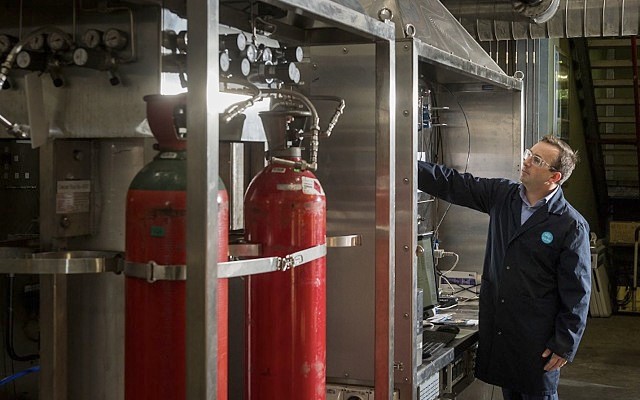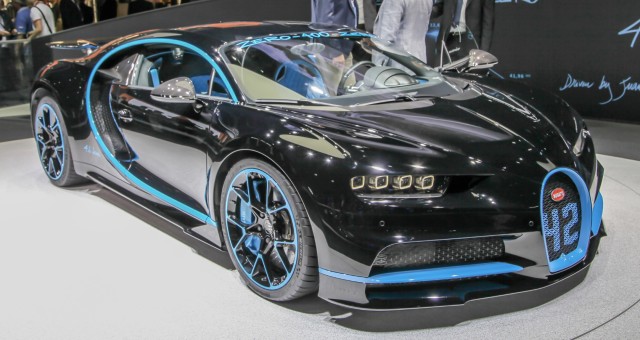CSIRO considers hydrogen as potential replacement for hydrocarbons and petrol

The Toyota Mirai fuel-cell sedan runs on hydrogen and produces zero emissions.
Petrol-powered cars are gradually being squeezed out by more energy-efficient lithium-battery-powered alternatives, with consumers rapidly adopting electric vehicles (EVs) worldwide.
However, there could be an even more efficient method of powering vehicles and machinery: hydrogen.
That’s the view coming from Australia’s national science agency, the CSIRO, which has developed a method for bulk hydrogen to be transported in the form of ammonia, using existing infrastructure, and then reconverted back to hydrogen at the point of use.
If implemented, CSIRO’s ammonia-based method has the potential to fill the gap in the technology chain to supply fuel cell vehicles around the world with low-emissions hydrogen sourced from Australia.
This would mean that hydrogen is transported and stored in a simple and safe way and allowing bulk hydrogen to be safely transported in the form of liquid ammonia.
CSIRO’s vision could lead to the use of hydrogen as a fuel and the building of extensive infrastructure to supply pure hydrogen to consumers.
Electric and hydrogen vehicles
Lithium-ion batteries have enabled consumers to adopt EVs in the hope of saving on fuel costs and reducing the impact on the environment. But hydrogen could offer even more fuel efficiency and even greater savings for car makers.
Just like EVs, hydrogen cars are also at the early stage of development but have been touted as a potential rival to EVs which plug into the electricity grid to recharge.
Meanwhile, hydrogen cars use hydrogen that’s pumped in and then converted to electricity via an onboard “fuel cell stack”, before being stored in a battery. One of the huge advantages over EVs is that hydrogen cars would only take a few minutes to fully refuel.
According to the CSIRO, this technology could pave the way for bulk hydrogen to be transported in the form of ammonia, using existing infrastructure, and then reconverted back to hydrogen at the point of use.
Why hydrogen and why now?
Hydrogen is being considered as “the fuel of the future” and following research conducted by the CSIRO, that future could become a reality much sooner than first thought.
The prime reason why the CSIRO is looking at hydrogen as a supplementary alternative to hydrocarbon-powered fuels is efficiency with the agency providing four key reasons why its technology improves upon the fossil-fuel-powered status quo.

Inside the CSIRO hydrogen lab.
For one, hydrogen is highly abundant in the Earth’s atmosphere which alleviates any supply issues.
Secondly, it is a clean fuel with water as the only waste product as opposed to carbon dioxide in the case of hydrocarbons – considered to be pollutive and toxic to the environment.
Third, hydrogen is highly adaptable which means it can be burnt like petrol or produce electricity in a portable fuel cell like a battery.
Last but not least, and possibly its biggest advantage, is that hydrogen can be generated using various different methods, including the generation of electricity using renewable sources like solar.
When hydrogen is used to power a fuel cell, a chemical reaction between the hydrogen molecule and oxygen creates an electrical current which is yet another potential benefit for car makers.
There are, however, some challenges that hydrogen-powered cars are facing. Namely, hydrogen’s low density makes the gas voluminous which creates transport and storage difficulties.
This factor has prevented hydrogen cars from being produced and marketed en masse – but that could soon change following CSIRO’s plan to generate pure hydrogen directly at the point of sale locations such as petrol stations.
From an efficiency perspective, hydrogen cars have the potential to eclipse EVs by a large margin, and therefore, could become the long-term viable alternative to hydrocarbons. Not only that, but the power locked up in hydrogen could far exceed previous estimates.
Hydrogen world record
Highlighting the power-potential of hydrogen, students from Duke University in North Carolina have set a world record for hydrogen fuel cell fuel economy by achieving a staggering 14,573 miles per gallon.
The record was set at Galot Motorsports, a racetrack in Benson, North Carolina in July.
The vehicle designed by Duke University has been dubbed the “Maxwell”, named after its original inventor James C Maxwell.
According to Duke University, Maxwell circled a test track for 8.5 miles using just one gram of pure hydrogen.

World record breaking vehicle ‘Maxwell’ circled a test track for 8.5 miles consuming only one gram of pure hydrogen.
“To put that in perspective, our vehicle is capable of driving to any point on the globe using the energy in one gallon of gas,” said Patrick Grady, outgoing president of the Duke Electric Vehicles (DEV) club.
“This world record is a perfect example of how our outrageously ambitious educational and research activities in Duke Engineering lead to remarkable and tangible results in the field of sustainable energy,” said Nico Hotz, assistant professor of mechanical engineering and adviser to the DEV club.
“By creating a collaborative and open environment and community, we enable our students to reach ground-breaking results,” he added.
“Building off the success of our hydrogen fuel cell vehicle, we are hoping to beat the battery electric vehicle record next year. Our electric efficiency is within 5% of the record based on our data from the recent attempt, so with improvements to the aerodynamics of the body and reduction in weight, we should be viable competitors for the record,” said Shomik Verma, incoming president of the DEV club.

The Bugatti Chiron guzzles fuel through its 8-litre engine.
By way of comparison, the current market front-runner is the Hyundai Ionic, an electric vehicle which can achieve 136 miles per gallon. The car with the worst fuel economy is currently the Bugatti Chiron, an 8-litre turbo-charged sports car that achieves 11 miles per gallon.
Hydrogen in the present
Despite hydrogen being an experimental fuel and in the early stages of mass commercialisation, that hasn’t stopped several manufacturers taking early steps in the industry.
The Toyota Mirai and Hyundai Nexo are vehicles already in production – powered by ultra-high purity hydrogen and first produced in Queensland using CSIRO’s membrane technology.
Toyota currently has several Mirai models on trial in Australia and Hyundai has said it plans to launch the Nexo SUV “in limited numbers” before the end of 2018.
As it stands, the early-stage nature of the technology means hydrogen cars come with a prohibitive purchase premium and are unlikely to be adopted in large numbers at least for the next five years.
Even without the initial cost, there also needs to be plenty of hydrogen service stations for the fuel to be accessible for drivers.
According to industry analysts, the high-tech and low-scale of production at this early stage means prices are high and remain in the $60,000-$100,000 bracket – a price considered too high for a small commuter car.
Therefore, the first instances of hydrogen-powered cars could be trucks and haulage vehicles that benefit most from fuel economy.
“This is a watershed moment for energy, and we look forward to applying CSIRO innovation to enable this exciting renewably-sourced fuel and energy storage medium a smoother path to market,” said Dr Larry Marshall, chief executive officer of CSIRO.
Australia’s energy mix is changing with hydrogen adoption growing both domestically and overseas.
According to the CSIRO, hydrogen could constitute 15% of global energy demand by 2050 which would entail buidling a network of hydrogen service stations and a network infrastructure that resembles today’s oil (petrol) industry.
That may still be some years away, but when hydrogen finally makes it to market, the all-encompassing industry it creates could generate as much as US$2.5 trillion per year.
